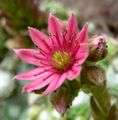Sempervivum arachnoideum
| Sempervivum arachnoideum | |
|---|---|
 | |
| Scientific classification | |
| Kingdom: | Plantae |
| (unranked): | Angiosperms |
| (unranked): | Eudicots |
| (unranked): | Core eudicots |
| Order: | Saxifragales |
| Family: | Crassulaceae |
| Genus: | Sempervivum |
| Species: | S. arachnoideum |
| Binomial name | |
| Sempervivum arachnoideum L. | |
Sempervivum arachnoideum, sometimes known as cobweb house-leek,[1] is a species of flowering plant in the family Crassulaceae, native to the Alps, Apennines and Carpathians. Growing to 8 cm (3 in) tall by 30 cm (12 in) wide, it is a rosette-forming succulent perennial, valued in cultivation for its ability to colonise hot, dry areas via offsets.[2] Its name arachnoideum refers to its furry central rosettes, resembling spider webs.[3] It flowers in July, with pink flowers that are raised on stems and hermaphrodite (having both male and female organs).
This plant has gained the Royal Horticultural Society's Award of Garden Merit.[4]
References
- ↑ "BSBI List 2007". Botanical Society of Britain and Ireland. Archived from the original (xls) on 2015-02-25. Retrieved 2014-10-17.
- ↑ RHS A-Z encyclopedia of garden plants. United Kingdom: Dorling Kindersley. 2008. p. 1136. ISBN 1405332964.
- ↑ Harrison, Lorraine (2012). RHS Latin for gardeners. United Kingdom: Mitchell Beazley. p. 224. ISBN 9781845337315.
- ↑ "RHS Plant Selector - Sempervivum arachnoideum". Retrieved 3 June 2013.
 S. arachnoideum flower
S. arachnoideum flower Another flower
Another flower Characteristic "spider web" on a rosettes
Characteristic "spider web" on a rosettes
This article is issued from Wikipedia - version of the 10/29/2016. The text is available under the Creative Commons Attribution/Share Alike but additional terms may apply for the media files.